Fentanyl Detox Timeline, Withdrawal Symptoms & Treatment
Fentanyl addiction can leave individuals feeling out of control and powerless, but completing fentanyl detox can help restore a sense of control and confidence in overcoming substance use disorders. Read more about the fentanyl detox timeline, withdrawal symptoms, and treatment options.
By We Level Up | Editor Yamilla Francese | Clinically Reviewed By Lauren Barry, LMFT, MCAP, QS, Director of Quality Assurance | Editorial Policy | Research Policy | Last Updated: May 9, 2023
Fentanyl Detox Overview
Quitting fentanyl “cold turkey,” or abruptly stopping fentanyl use without medical supervision, can be dangerous and potentially life-threatening. Fentanyl, just like all other opioids, can lower a person’s respiratory rate, heart rate, and blood pressure. If fentanyl is suddenly stopped, these systems can go haywire. People can experience a sudden increase in blood pressure, leading to strokes or heart attacks. Moreover, detoxing from fentanyl cold turkey has many long-lasting emotional issues. Without medical assistance, people who try to quit cold turkey can experience dangerous side effects and are at increased risk of relapse and harm.
Medical detox is always recommended for opioids like fentanyl. Medical specialists can get patients on weaning off schedule, where they are given ever-decreasing doses of fentanyl. Or, doctors can completely replace the drug with Buprenorphine/Naltrexone. Giving the body time to wean off an opioid will lessen the severity and duration of withdrawal symptoms.
Fentanyl Withdrawal Timeline
People also undergo different symptoms during each phase of fentanyl withdrawal. How long is fentanyl withdrawal? There are three main stages of withdrawal. These are the early, peak, and long-term effects.
| Early Symptoms (2 to 4 Hours After Last Dose) | The earliest symptoms of fentanyl withdrawal involve slight bodily discomforts, such as constant yawning, aches, and chills. Physical symptoms may come with anxiety, restlessness, and an intense craving for drug use. |
| Peak Symptoms (24 to 36 Hours After Last Dose) | Peak symptoms may last about a week after the last dose. Symptoms may include an increase in earlier withdrawal effects. Individuals may also experience additional symptoms requiring medical care, such as fever and vomiting. |
| Late Withdrawals From Fentanyl (Several Weeks or Months) | While the acute symptoms of fentanyl withdrawal typically subside within a few weeks, some individuals may experience persistent symptoms lasting for several months or longer. These may include anxiety and depression, insomnia and sleep disturbances, fatigue and low energy, difficulty concentrating and memory problems, mood swings and irritability, and cravings for fentanyl or other opioids. |
These long-term effects of fentanyl withdrawal can be managed through ongoing treatment, such as behavioral therapies, counseling, and support groups. Medications may also be used to manage symptoms and reduce the risk of relapse. Recovery from fentanyl addiction is a lifelong process, and ongoing support and treatment are essential for maintaining sobriety and preventing relapse.
Fentanyl Patch Withdrawal
The withdrawal symptoms associated with fentanyl patch withdrawal are comparable to those of other opioids and can be severe. Symptoms may include:
- Anxiety and restlessness.
- Insomnia.
- Sweating and chills.
- Muscle and bone pain.
- Nausea and vomiting.
- Diarrhea.
- Dilated pupils.
- Runny nose and teary eyes.
Fentanyl patches are a form of opioid pain medication that delivers fentanyl through the skin over an extended period. If a person has been using fentanyl patches for an extended period, they may develop a physical dependence on the drug. When the patches are discontinued or removed, withdrawal symptoms can occur.
Fentanyl Withdrawal Symptoms
What are the withdrawal symptoms of fentanyl? The timeline of fentanyl withdrawal is determined by several factors, including the individual’s level of dependence, the duration and frequency of use, and the method (e.g., oral, injection, or patch). Generally, fentanyl withdrawal follows the following timeline:
- Early withdrawal symptoms can start within hours of the last dose and typically peak within the first few days. Early symptoms may include:
- Anxiety and restlessness.
- Insomnia.
- Sweating and chills.
- Muscle and bone pain.
- Nausea and vomiting.
- Diarrhea.
- Dilated pupils.
- Runny nose and teary eyes.
- Peak withdrawal symptoms can occur between days 3 and 5 and may include:
- Intense cravings for fentanyl.
- Severe muscle and bone pain.
- Abdominal cramps and diarrhea.
- Nausea and vomiting.
- Profuse sweating and chills.
- High blood pressure.
- Rapid heart rate.
- Tremors and seizures.
- Late withdrawal symptoms may last for several weeks or even months after the last dose and can include:
- Depression and anxiety.
- Fatigue and low energy.
- Insomnia.
- Irritability and mood swings.
- Difficulty concentrating.
How Long Does Fentanyl Withdrawal Last?
Generally, the acute symptoms of fentanyl withdrawal can last for several days to a few weeks. The early signs may start within hours of the last dose and typically peak within the first few days. The peak symptoms may occur between days 3 and 5. They may include intense cravings for fentanyl, severe muscle and bone pain, abdominal cramps and diarrhea, nausea and vomiting, profuse sweating and chills, high blood pressure, rapid heart rate, tremors, and seizures.
After the acute withdrawal period, some individuals may experience persistent symptoms lasting for several weeks or even months. These may include anxiety, depression, insomnia, fatigue, difficulty concentrating, and mood swings.
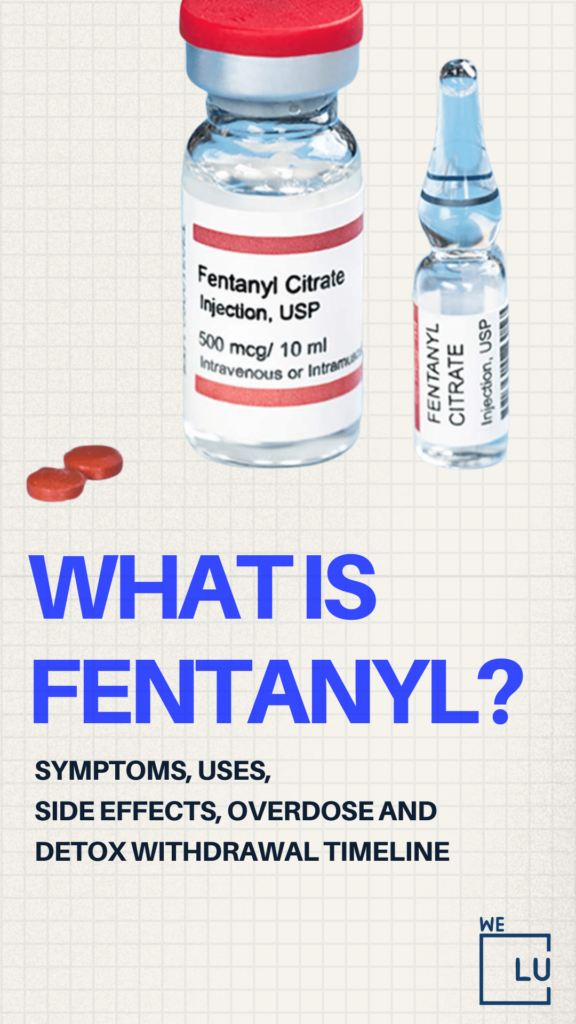
Skip To:
Learn More:
- Fentanyl Addiction
- Fentanyl Withdrawal Timeline
- Withdrawal From Fentanyl
- Fentanyl Rehab
- What is Fentanyl? Rainbow Fentanyl Symptoms, Uses, Side Effects, Overdose & Detox Withdrawal Timeline
- What Does Fentanyl Do To You? Abuse, Side Effects & Treatment
- How Long Does Fentanyl Stay In Your System, Urine, Blood, Salvia & Hair? Fentanyl Drug Test Duration Chart.
- Signs of Fentanyl Overdose, Addiction Signs to Look for & Addiction Treatment
- What Does Fentanyl Look Like? Rainbow Fentanyl, Colored Candy Fentanyl, Skittles Fentanyl Images, Facts, Warnings, & FAQs
- What Does Fentanyl Taste Like? Does Fentanyl Have a Taste? Fentanyl Taste FAQs & Facts
The timeline of fentanyl withdrawal can vary from person to person. It may be influenced by several factors, including the individual’s overall health and other medical or psychiatric conditions. Seeking professional medical help and support during fentanyl withdrawal is recommended to ensure a safe and comfortable detoxification process.
Get Help. Get Better. Get Your Life Back.
Searching for Accredited Drug and Alcohol Rehab Centers Near You?
Even if you have failed previously and relapsed, or are in the middle of a difficult crisis, we stand ready to support you. Our trusted behavioral health specialists will not give up on you. When you feel ready or just want someone to speak to about therapy alternatives to change your life call us. Even if we cannot assist you, we will lead you to wherever you can get support. There is no obligation. Call our hotline today.
(844) 597-1011How To Get Fentanyl Out Of Your System Faster? Infographic
Attempting to detox from fentanyl on your own can be harmful and should be done under the guidance of a healthcare provider. Suddenly stopping fentanyl can result in severe withdrawal symptoms and can be life-threatening. If you are struggling with fentanyl addiction or dependence, seek professional medical help and support.
There are no guaranteed ways to get fentanyl out of your system faster, as the body naturally eliminates the drug over time. However, there are some practices you can take to help your body detoxify and remove fentanyl more efficiently. Embed “How To Get Fentanyl Out Of Your System Faster?” Infographic to your Website. This fentanyl infographic is provided by the We Level Up addiction treatment center team. To use the above infographics, you agree to link back and attribute its source and owner at https://welevelup.com/treatment/fentanyl-detox/
Infographic image link: https://welevelup.com/wp-content/uploads/2023/04/How-To-Get-Fentanyl-Out-Of-System-Faster-1024×1024.jpg
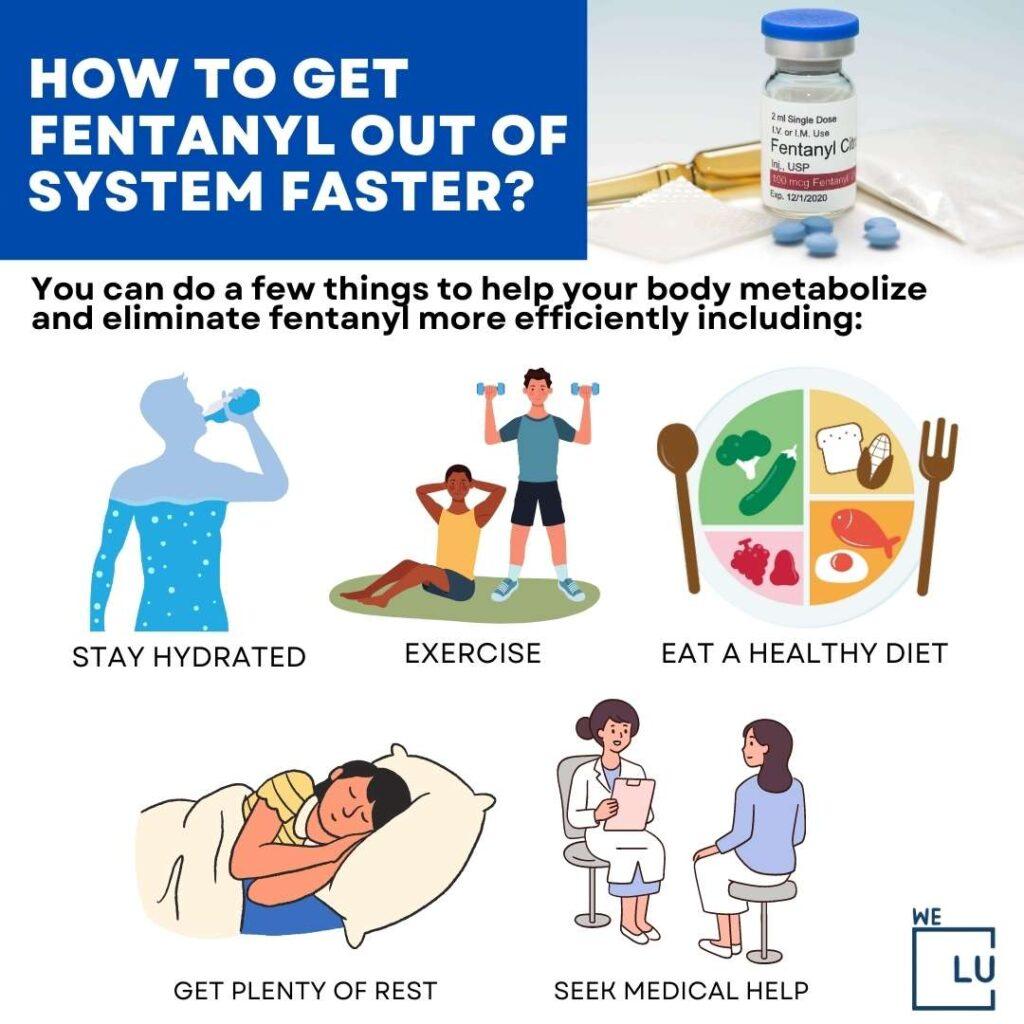
Fentanyl withdrawal symptoms may include intense cravings for fentanyl, severe muscle and bone pain, abdominal cramps and diarrhea, nausea and vomiting, profuse sweating and chills, high blood pressure, rapid heart rate, tremors, and seizures. After the acute withdrawal period, some individuals may experience persistent symptoms lasting for several weeks or even months. These may include anxiety, depression, insomnia, fatigue, difficulty concentrating, and mood swings. It’s crucial to seek professional medical help and support during fentanyl detoxification to ensure a safe and comfortable detox process.
Fentanyl Drug Facts
Generic Name: Fentanyl
Drug Class: Opioids (narcotic analgesics)
Dosage Form: Injection, transdermal patch, nasal spray, sublingual tablet, sublingual spray, transmucosal lozenge (lollipop)
Brand Names: Actiq (lozenge), Fentora (sublingual tablet), Subsys (sublingual spray), Lazanda (nasal spray)
Is Fentanyl Addictive?
Synthetic opioids, like fentanyl, are currently the most frequently used medications in overdose deaths in the United States. Fentanyl is a powerful synthetic opioid prescription drug and is commonly abused. It is 50 to 100 times more effective than morphine. It is a prescribed medicine that is also illegally manufactured and utilized. It, like morphine, is often used to treat people with acute pain, particularly after surgery.
It is also used to treat chronic pain sufferers who are physiologically resistant to other opioids. Tolerance develops when you require a more significant and frequent dose of a medicine to achieve the intended effects. Fentanyl is sold under Actiq, Duragesic, and Sublimaze in the United States.
When prescribed by a medical professional, fentanyl can be administered as an injection, a patch applied to the patient’s skin, or tablets like cough drops. Fentanyl, linked to recent overdoses, is manufactured in laboratories. This synthetic fentanyl is marketed illegally as a powder, blotter paper, eye droppers, nasal sprays, or tablets that resemble other prescription opioids.
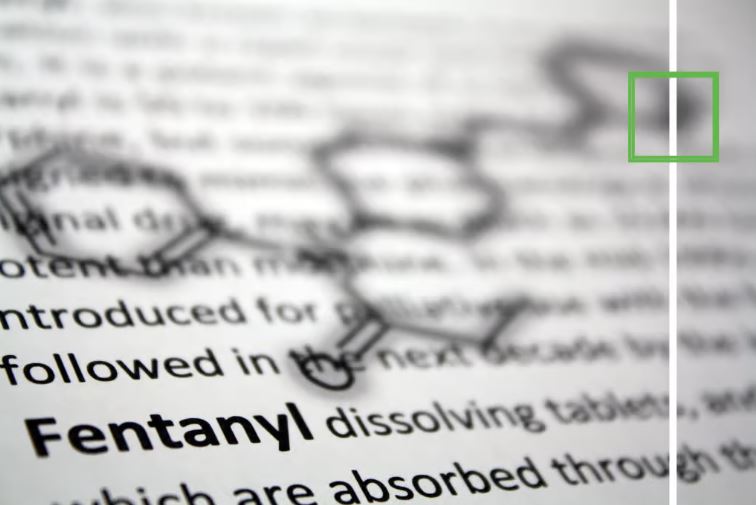
Fentanyl Detox Symptoms
Fentanyl produces euphoric effects, pushing people to start abusing the drug in the first place. It makes the user feel good. That’s why many people take it recreationally, not knowing the risks. And if a person is already addicted, attempting to quit without proper treatment will result in withdrawal from fentanyl, also known as fentanyl detox symptoms. These can include:
- Fentanyl cravings.
- Goosebumps.
- Runny nose.
- Increased tearing.
- Sweating.
- Hot and cold flashes.
- Excessive yawning.
- Insomnia.
- Nausea.
- Vomiting.
- Diarrhea.
- Muscles ache.
- Joint pain.
- Weakness.
- Stomach cramps.
- Anxiety.
- Agitation.
Why Should You Not Attempt Fentanyl Detox at Home Alone?
Detoxing from fentanyl at home without medical assistance is not recommended. Fentanyl is a powerful opioid that can cause physical dependence, and sudden cessation or tapering off of the drug can result in withdrawal symptoms that range from mild to severe.
Furthermore, by itself, detox isn’t enough. Medical detoxification alone does little to change long-term drug use, but it is a good start. The problem is that many people undergoing detox do not move on to rehab procedures afterward. Rehab is where the true healing for addiction occurs. In recovery, people learn how to live without giving in to their substance abuse.
Fentanyl Withdrawal Death
One of the most severe complications of fentanyl withdrawal is dehydration, which can occur due to vomiting, diarrhea, and sweating. Dehydration can lead to electrolyte imbalances, which can cause heart rhythm disturbances and other complications. Moreover, fentanyl withdrawal can cause rapid heart rate, high blood pressure, and other cardiovascular symptoms, which can be hazardous for people with pre-existing heart conditions.
Furthermore, individuals who experience severe fentanyl withdrawal symptoms, such as seizures or delirium, may be at increased risk of accidental injury or death.
Fentanyl Withdrawal Treatment
Fentanyl withdrawal treatment typically involves medication-assisted treatment (MAT) and supportive care to manage withdrawal symptoms and help individuals achieve and maintain recovery.
Medication-assisted treatment involves using medications to manage withdrawal symptoms and reduce drug cravings. Common medicines for fentanyl withdrawal include buprenorphine, methadone, and naltrexone.
- Buprenorphine, a partial opioid agonist, can lessen withdrawal symptoms and drug cravings without producing the euphoric effects of fentanyl. Methadone is a full opioid agonist that can also reduce withdrawal symptoms and drug cravings, but it requires careful monitoring due to the risk of addiction and overdose.
- Naltrexone is an opioid antagonist that hinders the effects of opioids and can help reduce drug cravings. It is typically used after the initial detox period to help prevent relapse.
In addition to medication-assisted treatment, supportive care can help manage fentanyl withdrawal symptoms. This can include counseling, therapy, and support groups to address addiction’s psychological and emotional aspects and medical care to manage physical symptoms or complications.
It is essential to seek professional help from a qualified healthcare provider or addiction specialist if you struggle with fentanyl addiction and withdrawal. They can provide a comprehensive assessment and develop an individualized therapy plan that meets your requirements and recovery goals.
Fentanyl Drug Fact Sheet
Download the below DEA’s fentanyl drug fact sheet. This file is publicly made available to help opioid use disorder awareness. Fentanyl drug is a powerful synthetic opioid that is responsible for a significant number of drug overdose deaths. The risk of overdose and death from fentanyl is exceptionally high when the drug is obtained illegally and used without medical supervision. Fentanyl is often mixed with other drugs like heroin, cocaine, or methamphetamine, increasing the risk of overdose and death.
The effects of fentanyl on the body can be hazardous, as the drug can slow or stop breathing, leading to hypoxia, brain damage, and death. In addition, fentanyl can be more potent than other opioids, which means that even a tiny amount of the drug can be deadly.
It is crucial to seek addiction treatment and medical help if you or someone you’re concerned with is struggling with fentanyl use, as the risk of overdose and death is high. There are many effective treatments available for fentanyl addiction, including medication-assisted treatment, counseling, and support groups, that can help individuals achieve and maintain recovery.

Get Your Life Back
Find Hope & Recovery. Get Safe Comfortable Detox, Addiction Rehab & Dual Diagnosis High-Quality Care.
Hotline(844) 597-1011Fentanyl Statistics
Most recent fentanyl overdose and death incidents in the United States have been connected to illegally manufactured fentanyl. It is marketed on the black market for its heroin-like effects. It is frequently blended with heroin and cocaine as a combination drug, with or without the abuser’s awareness, to enhance its euphoric effects.
36,000
In 2019, overdoses using synthetic opioids, particularly fentanyl, killed approximately 36,000 individuals.
Source: CDC
16%
Overdose fatalities using fentanyl and fentanyl analogs (carfentanil) increased by more than 16% from 2018 to 2019.
Source: CDC
59.8%
Fentanyl was implicated in 59.8 percent of opioid-related fatalities in 2017, compared to 14.3 percent in 2010.
Source: NIDA
Fentanyl Detox Timeline
How long does fentanyl withdraw last? The timeline for fentanyl detox can vary based on several aspects, including the person’s level of dependence on the drug, the severity of their addiction, and overall health. Generally, the following is a typical timeline for fentanyl detox:
| Days 1-2 | Fentanyl withdrawal symptoms typically begin within 12-30 hours after the last use of the drug. Early symptoms can include anxiety, restlessness, insomnia, sweating, and muscle aches. |
| Days 3-5 | Symptoms usually peak around days 3-5, including nausea, vomiting, diarrhea, abdominal cramps, and fever. |
| Days 6-7 | Symptoms begin to subside after the first week of withdrawal, but some individuals may experience lingering symptoms such as fatigue, depression, and insomnia. |
| Days 7-14 | Most physical symptoms of fentanyl withdrawal have resolved by the end of the second week of detox, but psychological symptoms such as depression, anxiety, and drug cravings may persist. |
What Helps Fentanyl Withdrawals?
We Level Up’s fentanyl detox program has three distinct stages that focus on different elements of helping people overcome withdrawal symptoms from fentanyl. Each detox step is carefully designed to ensure people struggling with fentanyl addiction get the exact help they need and have the best overall chances of recovery.
Assessment
The first step in the fentanyl detox program is a thorough and detailed assessment process. This stage happens as soon as people enter a medical detox and is designed to help our team build a customized treatment plan for your withdrawal process. This assessment covers several domains, including substance use, physical health, and any mental health symptoms you may be experiencing. When you reach out to us, our team may ask you:
- How long have you been using fentanyl?
- When was your last fentanyl dose?
- What is your typical fentanyl dose?
- How frequently do you use fentanyl throughout the day?
- Do you use any other addictive substances alongside fentanyl?
- Do you have any pre-existing health conditions?
- Are you experiencing any symptoms of mental illness?
Once our team completes this assessment, they will make a completely personalized treatment plan to ensure your withdrawal process goes as smoothly as possible. This plan will account for any conditions or mental health symptoms impacting the treatment process. Our knowledgeable medical staff will answer any questions about your treatment plan and help you understand what to expect during therapy.
Stabilization
The next step of treatment is referred to as the stabilization stage. This step takes up the bulk of the medical detox process. It is when people receive targeted medications and treatments that can help them overcome physical and psychological symptoms of withdrawal.
During this phase, experienced professionals medically supervise clients 24 hrs. a day, seven days a week. This includes basic health assessments, such as checking your blood pressure and monitoring your respiration.
It also helps our team assess your progress through treatment, gauge how well you are responding to your opioid addiction medications, and provide emotional support in a difficult time.
The stabilization phase is performed in a residential treatment environment, where clients are free from the temptations and triggers of the outside world. Our team will prepare all of your meals, provide whatever you need to feel comfortable and allow you to focus your energy on feeling better and preparing for the next phase of treatment.
Withdrawing from fentanyl is never easy, but the stabilization phase makes it much more comfortable, manageable, and achievable than when people attempt to quit alone.
What Is A Fentanyl Detox?
The method of removing fentanyl from the body safely is called detox, which is the removal of toxic substances from the bloodstream.
This process is usually performed in a specialized substance abuse treatment center. Detox can be part of either a residential or an inpatient program, depending on the specific needs of the individual.
Typically, residential detox is called medical detox, which includes medical and mental health support provided by highly trained professionals around the clock. Vital signs are monitored to ensure each individual’s safety, and medications are also often used to manage physical and emotional withdrawal symptoms. A residential detox is usually recommended for fentanyl withdrawal as it is a powerful opioid.
Transition
The final stage of detox treatment is the transition of care. Medical detox is a critical initial step in recovery but is typically insufficient to produce long-term sobriety. People struggling with fentanyl addiction must transfer to an addiction treatment center to maintain the hard-won abstinence they achieved in detox.
We Level Up’s detox and addiction care transition is seamless. We Level Up’s treatment network covers the entire continuum of care, allowing our different treatment facilities to work together to build an overall treatment plan from the beginning.
For you as the client, the transition phase is when medical treatments typically end, and you prepare to transfer to a new facility. You have several options for your future addiction treatment, and our team will ensure that you are fully equipped before moving on the new journey of a life drug-free.

The type of detox a person must undergo depends on many factors. In some cases, a person can choose to detox at home. But even at home, the person needs to have proper supervision. Additionally, the individual will need examination by a professional to ensure that the detox process is going smoothly. The monitoring process is also vital during treatment. Medical professionals monitor the detox process and ensure that it’s working correctly.
First-class Facilities & Amenities
World-class High-Quality Addiction & Mental Health Rehabilitation Treatment
Rehab Centers TourRenowned Addiction Centers. Serene Private Facilities. Inpatient rehab programs vary.
Addiction Helpline(844) 597-1011Proven recovery success experience, backed by a Team w/ History of:
15+
Years of Unified Experience
100s
5-Star Reviews Across Our Centers
10K
Recovery Success Stories Across Our Network
- Low Patient to Therapist Ratio
- Onsite Medical Detox Center
- Comprehensive Dual-Diagnosis Treatment
- Complimentary Family & Alumni Programs
- Coaching, Recovery & Personal Development Events
What Is Safe During Fentanyl Detox?
Fentanyl detox centers can help those suffering from addictions such as fentanyl misuse overcome their dependence without coming to harm. Consult a medical expert with experience in addiction treatment or withdrawal management before beginning a safe detox. This professional can give an in-depth examination of your current situation and dangers.
In determining a suitable treatment plan for you, they may ask you questions about the following:
- The type of substances you use regularly.
- The frequency, amount, and time of your use.
- Any pre-existing and concurrent mental health symptoms.
- Your physical health/medical history.
- Previous withdrawal and detox attempts.
- How much support do you have from your family or at home?
Your answers to these questions will aid in determining an appropriate level of treatment. Natural (or “cold turkey”) detox may be a possibility for a healthy person with no severe physical reliance or a history of use of a substance not generally linked with severe withdrawal symptoms (e.g., hallucinogens, specific inhalants) in rare cases.
What Isn’t Safe During Fentanyl Detox?
Detoxing at home or without appropriate withdrawal management may be unsafe with some types of substance dependence. In some instances, and with certain substances (such as fentanyl withdraws), abruptly quitting without medical withdrawal management can be risky.
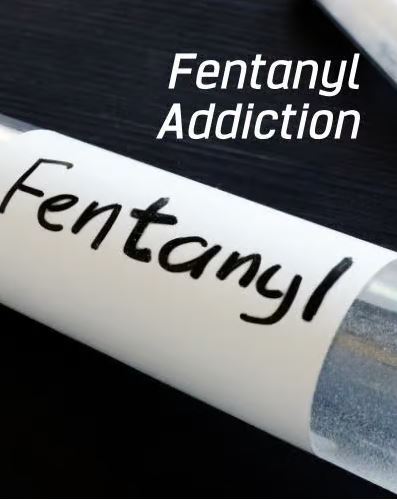
Detoxing at home can be dangerous if you experience progressively severe withdrawal symptoms and complications without medical care or assistance. For instance, when withdrawals are left unmanaged, detox from fentanyl can bring about withdrawal symptoms that can lead to death. Also, a relapse could increase if a person is subjected to an unpleasant withdrawal and has no plan for medical assistance.
Home detox from drugs is only an option for substances that do not cause severe withdrawal symptoms. However, remember that while there are few typical medical hazards, some unforeseen issues may develop. SAMHSA (Substance Abuse and Mental Health Services Administration) states several medical complications, such as nausea and vomiting, can occur during detoxes.
In cases where an altered level of consciousness is a factor, individuals may aspirate on their vomit, which can be fatal. The uncomfortable withdrawal symptoms and accompanying substance cravings can contribute to relapse or return to drug use when withdrawal signs and symptoms aren’t managed. Drug cravings can be tough to resist when withdrawal feels too uncomfortable. Getting professional addiction treatment support can make a significant difference in preventing relapse and making it to the next treatment step.
What Happens After Fentanyl Detox?
How long does it take to withdrawal from fentanyl? The acute phase of fentanyl withdrawal typically lasts 7-10 days, with some symptoms potentially persisting for several weeks or even months. After the first week of withdrawal, most physical symptoms of fentanyl withdrawal have resolved.
Still, psychological symptoms such as depression, anxiety, and drug cravings may persist for several weeks or months. That is why clients transfer to one of We Level Up’s dedicated addiction treatment facilities after completing a medical detox program. These facilities offer several levels of care to address addiction’s underlying issues and causes. The programs include the following:
Residential Rehab
Residential treatment is the next step for most people who abuse fentanyl. During residential treatment, clients live on-site at an addiction treatment facility with others working toward recovery and receive targeted and intensive therapies throughout the day. This includes several evidence-based treatment modalities, including:
- Individual therapy.
- Group therapy.
- Motivational interviewing.
- Relapse prevention programs.
- Family therapy.
- Medication-assisted treatment.
- Experiential therapies.
Together, these treatments help people build the tools and skills necessary for a lifetime in recovery. Residential rehab typically lasts between 30 and 90 days, though clients with severe opioid addictions may benefit from extending this period.
Partial Hospitalization Programs
PHPs are best suited to people with a safe and supportive environment to return home to at night but still need a high level of addiction care to sustain their recovery. In addition, many people transition to PHPs after completing a residential treatment program to extend the treatment process while slowly ramping down the intensity of care. One of the critical benefits of PHPs is that they allow people to practice the skills they’ve learned in treatment when they return home. Clients can put their coping mechanisms into practice and assess any real-world triggers or temptations they need to work on in therapy.
Dual-Diagnosis Programs
Dual-diagnosis programs are designed for people with co-occurring mental illness and addiction. Many people struggling with fentanyl addiction are also living with mental health disorders, such as:
- Depression.
- Anxiety.
- Bipolar disorder.
- Post-traumatic stress disorder.
- Attention deficit/hyperactivity disorder.
- Obsessive-compulsive disorder.
If they are left untreated, these mental health challenges can significantly increase the risk of relapse after somebody completes an addiction treatment program.
Clients undergo targeted mental health treatment alongside the best evidence-based methods for treating their substance use disorders at a dual-diagnosis treatment facility. This could include psychiatric evaluations, targeted mental health medications, specialized therapy programs, or cognitive health-focused support groups.
Dual-diagnosis treatment centers are offered in inpatient and residential settings and provide the highest level of care for people with co-occurring disorders.
Medical Fentanyl Detox
In a medical fentanyl detox facility, your withdrawal symptoms can be treated in real-time and adjusted accordingly. They can also provide emergency medical intervention if necessary. You can employ their expertise in managing and reducing withdrawal symptoms. The pain and discomfort of the detox will still be there, but it’s more manageable thanks to the medical team and the treatment they’ll be prescribing.
They’ll also create a treatment plan that addresses your fentanyl use, medical history, and physical and mental condition. Medical detox facilities provide holistic treatments and can involve programs and activities like counseling, meditation, group therapy, and yoga. While fentanyl addiction is prevalent, everyone is different and can benefit from a medically assisted treatment plan that considers their various needs. This sets you up for better, safer, and more long-term recovery than if you were to do it alone.
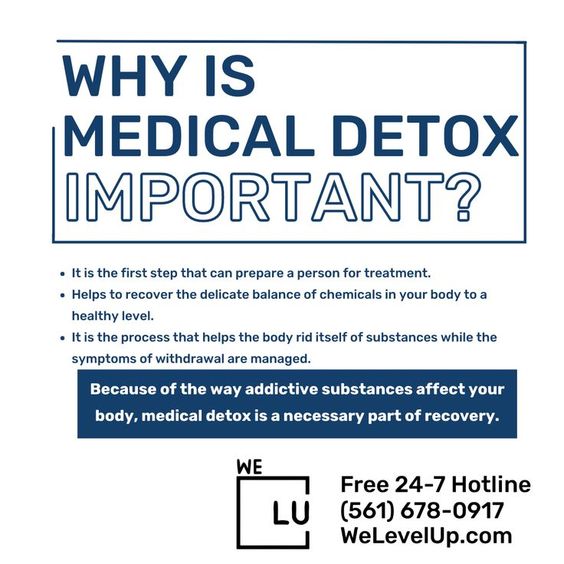

How Long Does Fentanyl Detox Last?
How long does fentanyl withdrawals last? Fentanyl detox might take several weeks or more, based on how your body system reacts to the medicine used to alleviate withdrawal symptoms. The higher the fentanyl dosage, the higher the dose of medication necessary to control and manage symptoms. This indicates that your fentanyl detox period may be extended. Medication might sometimes be taken for an extended period to help you avoid fentanyl and other opioids.
Fentanyl withdrawal symptoms include the following:
- Hot and cold flashes and sweating.
- Tearing eyes and runny nose.
- Muscle stiffness and aches.
- Nausea, vomiting, and diarrhea.
- Insomnia and anxiety.
Do not attempt detoxing from fentanyl alone since doing so has life-threatening consequences. Fentanyl is a short-acting opioid, meaning withdrawal symptoms (fentanyl withdrawal symptômes) can begin between 8 and 24 hrs. after the previous use and may last four to ten days.
Fentanyl Detox Near Me
When searching for a “fentanyl detox near me,” there are many things to consider. Here are some crucial factors to keep in mind:
- Accreditation and Licensing: It is vital to ensure that the detox center is licensed and accredited by relevant organizations, such as the Joint Commission or the CARF (Commission on Accreditation of Rehabilitation Facilities.) This ensures that the center meets specific quality standards and has undergone regular inspections and evaluations.
- Treatment Philosophy and Approach: Different fentanyl detox centers may have different treatment philosophies and approaches. Some focus on medication-assisted treatment, while others emphasize holistic or alternative therapies. Choosing a detox center whose approach aligns with your personal preferences and values is essential.
- Staff Qualifications and Experience: The quality and experience of the staff can be an essential factor in the success of your detox and recovery. Look for a center that employs qualified and experienced healthcare providers, addiction specialists, therapists, and support staff.
- Location and Amenities: The location and amenities of the detox center can also be crucial considerations. Some individuals prefer a center close to home, while others benefit from a more secluded or serene location. Additionally, amenities such as private rooms, outdoor spaces, and recreational activities may be important factors for some individuals.
- Cost and Insurance: The cost of detox and addiction treatment can vary widely, and choosing a center that fits your budget and insurance coverage is essential. Be sure to ask about the treatment costs and any available payment options or financial assistance programs.
- Aftercare and Support: Detox is often the first step in a more extended addiction treatment and recovery process. Look for a detox center that offers aftercare and support programs to help you continue your recovery and prevent relapse after leaving the center.
Overall, choosing an addiction detox center is an important decision that needs careful thinking and consideration of your needs and preferences. It would be best to speak with a qualified healthcare provider or addiction specialist who can help you find a detox center that is right for you.
Fentanyl addiction is a condition that can cause significant health problems, such as an overdose. We Level Up rehab treatment and detox facility can give you or someone you care about the skills they need to recover with professional and safe care. Don’t hesitate to contact us to meet with one of our counselors. We can educate you on this substance use disorder and address concerns such as fentanyl withdrawal symptoms. Our experts understand what you’re going through. Each call is private and confidential.
World-class, Accredited, 5-Star Reviewed, Effective Addiction & Mental Health Programs. Complete Behavioral Health Inpatient Rehab, Detox plus Co-occuring Disorders Therapy.
CALL(844) 597-1011End the Addiction Pain. End the Emotional Rollercoaster. Get Your Life Back. Start Drug, Alcohol & Dual Diagnosis Mental Health Treatment Now. Get Free No-obligation Guidance by Substance Abuse Specialists Who Understand Addiction & Mental Health Recovery & Know How to Help.
Top 5 How To Detox Off Fentanyl? FAQs
-
How long do fentanyl withdrawals last?
During the first 1-2 days of fentanyl withdrawal, individuals may experience early withdrawal symptoms, such as anxiety, restlessness, insomnia, sweating, and muscle aches. These symptoms may peak between days 3-5, with more severe symptoms such as nausea, vomiting, diarrhea, abdominal cramps, and fever. After the first week of withdrawal, most physical symptoms of fentanyl withdrawal have resolved. Still, psychological symptoms such as anxiety, depression, and drug cravings may persist for several weeks or months.
-
How long does it take to detox from fentanyl?
Fentanyl withdrawal how long? The duration of fentanyl withdrawal can vary based on several aspects, including the individual’s level of dependence on the drug, the severity of their addiction, and their overall health. Generally, the acute phase of fentanyl withdrawal typically lasts 7-10 days, with some symptoms potentially persisting for several weeks or even months.
-
What helps with fentanyl withdrawal?
Fentanyl withdrawal can be a difficult and uncomfortable experience, but several treatments and strategies can help manage withdrawal symptoms and support recovery. These treatments and strategies should be used under the guidance of a qualified healthcare provider or addiction specialist, who can monitor progress, adjust treatment as needed, and ensure a safe and successful recovery.
-
Can you die from fentanyl withdrawals?
While fentanyl withdrawal can be a difficult and uncomfortable experience, it is generally not considered life-threatening. However, withdrawal from opioids like fentanyl can cause a range of physical and psychological symptoms, some of which can be severe and require medical attention. Additionally, individuals who attempt to detox from fentanyl or other opioids without medical supervision may be at increased risk of relapse, overdose, or other complications.
-
How to detox from fentanyl at home?
It is not recommended to detox from fentanyl at home without medical supervision, as it can be unsafe and potentially life-threatening. Fentanyl is a potent drug that can cause severe withdrawal symptoms, including nausea, vomiting, diarrhea, anxiety, agitation, muscle pain, and insomnia. In some cases, withdrawal can also lead to seizures and respiratory distress, which can be fatal. If you or someone you’re concerned with is struggling with fentanyl addiction and wants to detox, the safest and most effective option is to seek professional medical help. A medical detox program can provide 24/7 medical supervision and support to manage withdrawal symptoms and ensure a safe and comfortable detoxification process. In a medical detox program, healthcare professionals may use medications to help manage withdrawal symptoms and reduce cravings.
How Long Do Opiates Stay in Your System? How Long Do Opiates Stay in Urine, Blood, & Body?
How Long Do Opiates Stay in Your System? Brief Video Transcript.
Drugs in the opioid class are used to treat pain. Natural opioids, semi-synthetic opioids generated from natural opioids, and synthetic opioids produced in a lab are all referred to as opioids under the general term. A class of medications known as opioids contain opiates, which are organic byproducts of the poppy plant. The main difference is that “opiate” refers to the substances derived from the opium (poppy) plant. At the same time, “opioids” are all substances that interact with opioid receptors, including those created in the lab.
The length of time that opiates remain in your system varies depending on the type of opiate, the dosage, and the frequency of use. Generally, opiates can stay in your system for two to four days. However, heavier and chronic users may have residues in their system for up to seven days.
Opiates can be detected in the blood test for up to 24 hours and in the urine test for up to three days. Opiates can be detected in the hair follicles for up to 90 days. In chronic users, opiates can stay in the body for up to 30 days.
Opiates often have short half-lives, meaning their effects can linger for several hours even though they swiftly leave the body. However, Opioids can linger in a person’s bloodstream for several hours or days after the symptoms subside, depending on the substance used. Urine tests, one of the more common types of drug testing, can identify opioid usage for longer periods of time, often up to three to four days, and some tests can identify opioid use for up to three months.
Get FREE addiction treatment insurance check – https://welevelup.com/rehab-insurance/ If you or a loved one is struggling with opiates addiction or other substance use disorder(s), call for a FREE consultation 24/7 at (561) 678-0917
Experience Transformative Recovery at We Level Up Treatment Centers.
See our authentic success stories. Get inspired. Get the help you deserve.
Start a New Life
Begin with a free call to an addiction & behavioral health treatment advisor. Learn more about our dual-diagnosis programs. The We Level Up Treatment Center Network delivers recovery programs that vary by each treatment facility. Call to learn more.
- Personalized Care
- Caring Accountable Staff
- World-class Amenities
- Licensed & Accredited
- Renowned w/ 100s 5-Star Reviews
We’ll Call You
Search We Level Up Fentanyl Detox, Mental Health Topics & Resources
Sources
[3] MedlinePlus.gov. Opiate and opioid withdrawal.
[4] Food and Drug Administration.
[5] What Is Fentanyl? Effective Treatment For Fentanyl Withdrawal And Addiction (welevelupnj.com)
[6] Ramos-Matos CF, Bistas KG, Lopez-Ojeda W. Fentanyl. [Updated 2022 May 30]. In: StatPearls [Internet]. Treasure Island (FL): StatPearls Publishing; 2023 Jan-. Available from: https://www.ncbi.nlm.nih.gov/books/NBK459275/
[7] Taylor KP, Singh K, Goyal A. Fentanyl Transdermal. [Updated 2022 Nov 9]. In: StatPearls [Internet]. Treasure Island (FL): StatPearls Publishing; 2023 Jan-. Available from: https://www.ncbi.nlm.nih.gov/books/NBK555968/
[8] Shah M, Huecker MR. Opioid Withdrawal. [Updated 2023 Jan 17]. In: StatPearls [Internet]. Treasure Island (FL): StatPearls Publishing; 2023 Jan-. Available from: https://www.ncbi.nlm.nih.gov/books/NBK526012/
[9] Fluyau D, Charlton TE. Drug Addiction. [Updated 2022 Aug 29]. In: StatPearls [Internet]. Treasure Island (FL): StatPearls Publishing; 2023 Jan-. Available from: https://www.ncbi.nlm.nih.gov/books/NBK549783/
[10] Substance Abuse and Mental Health Services Administration (US); Office of the Surgeon General (US). Facing Addiction in America: The Surgeon General’s Report on Alcohol, Drugs, and Health [Internet]. Washington (DC): US Department of Health and Human Services; 2016 Nov. CHAPTER 6, HEALTH CARE SYSTEMS AND SUBSTANCE USE DISORDERS. Available from: https://www.ncbi.nlm.nih.gov/books/NBK424848/


